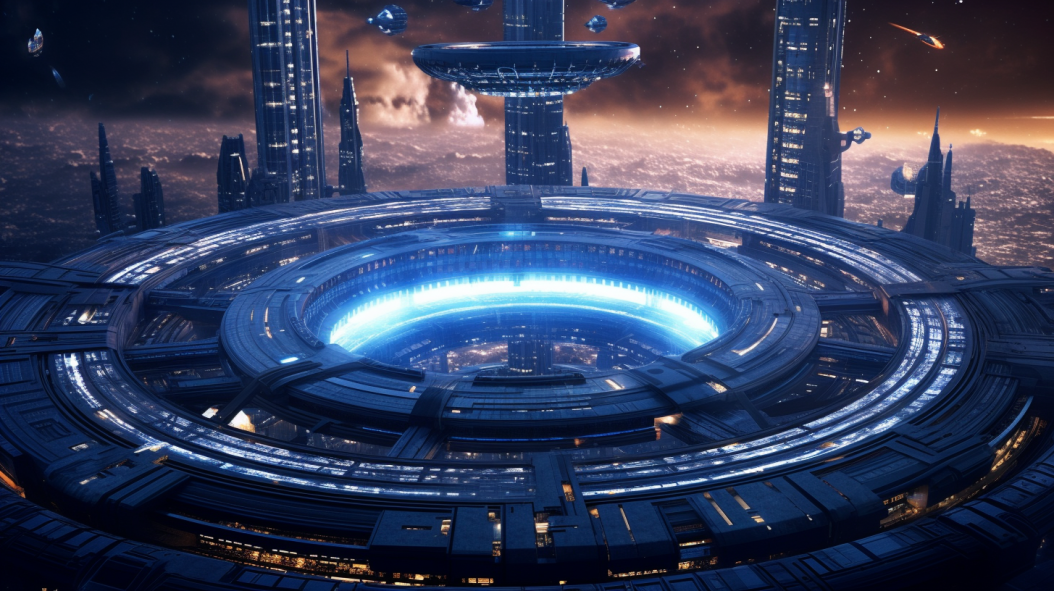Spinning Through Space: The Evolution of Artificial Gravity in Space Stations

Introduction
Space, the final frontier, has always fascinated humanity. From the early days of space exploration to the latest advancements in space technology, one aspect that continues to intrigue scientists and engineers alike is artificial gravity. In this blog post, we’ll explore the different projects of space stations with artificial gravity, from simple bolas of two Starships rotating around a center to large circular structures and beyond. So, buckle up and get ready to spin through space!
The Simple Bolas: Two Starships Rotating Around a Center
Concept
Imagine two Starships tethered together and rotating around a common center. This simple yet effective concept is known as a bola. By rotating the two Starships, artificial gravity is created, pulling objects towards the outer walls of the ships. What’s even more intriguing is that this concept can be applied to Starships in transit, allowing for a progressive adjustment of the tether’s length to simulate the gravity of the origin and destination.
Design
The design of a bola is relatively straightforward. Two Starships are connected by a strong cable or tether, and the entire system is set into rotation. During a journey from one celestial body to another, the tether’s length can be adjusted progressively. This allows for a gradual transition from the gravity of the origin to the gravity of the destination, providing a more natural experience for the passengers and crew.
Applications
The bola concept can be used for various purposes, such as:
- Research: Studying the effects of different gravity levels on the human body and other biological systems.
- Space Tourism: Providing a more Earth-like experience for space tourists, even during transit between different celestial bodies.
- Long-term Missions: Enhancing the comfort and well-being of astronauts on extended missions, including journeys to other planets or moons.
Large Circular Structures: The Next Step in Space Stations
Concept
Building on the bola concept, large circular structures take artificial gravity to the next level. These space stations consist of a massive ring that rotates, creating gravity within the structure.
Design
The design of a large circular space station involves intricate engineering. The ring must be constructed with precision to ensure stability during rotation. Docking ports can be added to allow Starships to dock for refueling or expanding the station’s capacity.
Applications
Large circular structures offer numerous applications, including:
- Refueling Stations: Serving as a pit stop for spacecraft needing to refuel.
- Research Facilities: Enabling advanced scientific research in a controlled gravitational environment.
- Space Colonization: Providing a potential habitat for long-term human presence in space.
The Ultimate Project: A Space Station with Concentric Rings
Concept
Imagine a space station with concentric rings, each providing the gravity of the Moon, Mars, and Earth. This ambitious project represents the pinnacle of artificial gravity technology.
Design
The design of this space station would be highly complex, featuring multiple rotating rings, each calibrated to a specific gravitational pull. The innermost ring could simulate lunar gravity, the next Martian gravity, and the outermost ring Earth’s gravity.
Applications
Such a space station could serve various purposes, including:
- Space Traveler Acclimation: Helping astronauts acclimate to different gravity levels before landing on other celestial bodies.
- Interplanetary Gateway: Acting as a hub for interplanetary travel and exploration.
- Scientific Research: Facilitating groundbreaking research in gravitational physics and space medicine.
Conclusion
The journey from simple bolas to large circular structures and concentric rings represents the evolution of artificial gravity in space stations. These innovative concepts not only push the boundaries of engineering but also open new horizons for space exploration, research, and colonization.
As we continue to reach for the stars, the development of artificial gravity will undoubtedly play a vital role in shaping our future in space. The possibilities are endless, and the sky is no longer the limit!